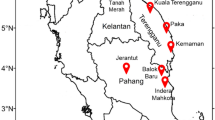Abstract
In order to classify the Telangana air pollution monitoring stations based on air pollution levels, this study aims to demonstrate the efficacy of hierarchical agglomerative cluster analysis (HACA). A multivariate technique called cluster analysis attempts to group similar items into one group by using a set of measured factors to categorise them. Monthly averages of PM10 and NOx were collected from Telangana State Pollution Control Board (TSPCB) website ranging from January 2016 to December 2019. HACA was successful in classifying monitoring stations into Low Pollution Source (LPS) region, Moderate Pollution Source (MPS) region and High Pollution Source (HPS) region based on the major pollutants PM10 and NOx. Out of 22 monitoring stations located at various districts of Telangana, 10 stations belong to HPS region with the average value of the AQI is 115 during the year, 8 stations belong to MPS region with the average value of the AQI is 82 during the year and 4 stations belong to LPS region with the average value of the AQI is 65 during the year. From the study, it can be stipulated that the application of HACA can disclose meaningful information on the spatial variability of a large and complex air quality data. The findings can aid the authorities concerned in applying different methods at various study sites such as implementing pollution control systems in industries, conducting awareness campaigns, staggered office and educational institutions operating hours.
Access this chapter
Tax calculation will be finalised at checkout
Purchases are for personal use only
Similar content being viewed by others
References
Cichowicz R, Wielgosiński G (2015) Effect of meteorological conditions and building location on CO2 concentration in the university campus. Ecol Chem Eng 22(4):513–525. https://doi.org/10.1515/eces-2015-0030
Gurney KR, Razlivanov I, Song Y, Zhou Y, Benes B, Massih MA (2012) Quantification of fossil fuel CO2 emissions on the building/street scale for a large U.S. city. Environ Sci Technol 46(21):12194–12202. https://doi.org/10.1021/es3011282
Lelieveld J, Evans JS, Fnais M, Giannadaki D, Pozzer A (2015) The contribution of outdoor air pollution sources to premature mortality on a global scale. Nature 525:367–371. https://doi.org/10.1038/nature15371
Nemitz E, Hargreaves KJ, McDonald AG, Dorsey JR, Fowler D (2002) Micrometeorological measurements of the urban heat budget and CO2 emissions on a city scale. Environ Sci Technol 36(14):3139–3146. https://doi.org/10.1021/es010277e
Vasudha N, Rao PV (2022) Factor analysis of air pollutants over Hyderabad-a case study. Curr World Environ 17(2). https://doi.org/10.12944/CWE.17.2.21
Koutrakis P, Sioutas C (1996) Physico-chemical properties and measurement of ambient particles. In: Wilson R, Spengler JD (eds) Particles in our air: concentrations and health effects. Harvard University Press, Harvard, pp 15–40
Schwartz J (1994) Air pollution and daily mortality: a review and meta-analysis. Environ Res 64:36–52
Dockery DW, Pope CA III (1996) Epidemiology of acute health effects: summary of time-series studies. In: Wilson R, Spengler JD (eds) Particles in our air: concentrations and health effects. Harvard University Press, Cambridge MA, pp 123–147
de Vries W (2021) Impacts of nitrogen emissions on ecosystems and human health: a mini review. Current Opinion Environ Sci Health 21:100249. ISSN 2468-5844. https://doi.org/10.1016/j.coesh.2021.100249
Chameides WL, Kasibhatla PS, Yienger J, Levy H (1994) Growth of continental-scale metro-agroplexes, regional ozone pollution, and world food production. Science 264(5155):74–77. https://doi.org/10.1126/science.264.5155.74
van der Eerden LJ, Duym N (1988) An evaluation method for combined effects of SO2 and NO2 on vegetation. Environ Pollution 53(1–4):468–470. ISSN: 0269-7491. https://doi.org/10.1016/0269-7491(88)90080-2
Acknowledgements
The authors would like to thank the management of Vasavi College of Engineering, Hyderabad, India. The authors acknowledge the state government of Telangana for providing online data in the website of TSPCB in the public domain.
Author information
Authors and Affiliations
Corresponding author
Editor information
Editors and Affiliations
Rights and permissions
Copyright information
© 2023 The Author(s), under exclusive license to Springer Nature Singapore Pte Ltd.
About this paper
Cite this paper
Vasudha, N., Rao, P.V. (2023). Telangana Air Pollution Stations Classification Using HACA. In: Kumar, A., Ghinea, G., Merugu, S. (eds) Proceedings of the 2nd International Conference on Cognitive and Intelligent Computing. ICCIC 2022. Cognitive Science and Technology. Springer, Singapore. https://doi.org/10.1007/978-981-99-2746-3_9
Download citation
DOI: https://doi.org/10.1007/978-981-99-2746-3_9
Published:
Publisher Name: Springer, Singapore
Print ISBN: 978-981-99-2745-6
Online ISBN: 978-981-99-2746-3
eBook Packages: Intelligent Technologies and RoboticsIntelligent Technologies and Robotics (R0)




